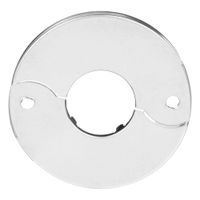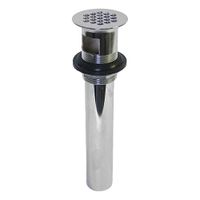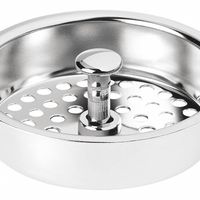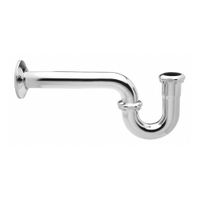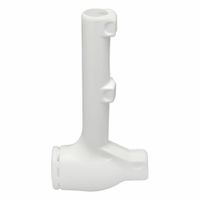Call +(254) 703 030 000 / 751 483 999 / 721 704 777
Frequently Asked Questions
What is the purpose of a sink drain strainer?
A sink drain strainer serves several important purposes in maintaining the functionality and hygiene of a sink. Primarily, it acts as a barrier to prevent solid debris, such as food particles, hair, and other waste materials, from entering the plumbing system. By catching these materials, the strainer helps to prevent clogs and blockages in the pipes, which can lead to costly plumbing repairs and potential water damage.
Additionally, a sink drain strainer aids in maintaining cleanliness and hygiene in the kitchen or bathroom. By trapping food scraps and other debris, it reduces the likelihood of unpleasant odors emanating from the drain. This is particularly important in kitchen sinks, where food waste can quickly decompose and cause foul smells.
The strainer also plays a role in protecting the environment. By preventing solid waste from entering the sewage system, it reduces the burden on wastewater treatment facilities and helps to prevent pollution in natural water bodies. This is especially relevant in areas where waste management systems are already under strain.
Moreover, sink drain strainers are typically easy to install and maintain. They can be easily removed for cleaning, ensuring that they remain effective in trapping debris. Regular cleaning of the strainer is essential to maintain its functionality and to prevent the buildup of bacteria and mold.
In summary, a sink drain strainer is a simple yet effective tool that prevents clogs, maintains hygiene, protects the environment, and is easy to maintain, making it an essential component of any sink.
How do I unclog a sink drain?
To unclog a sink drain, start by removing any visible debris from the sink and drain area. Use a plunger to create suction over the drain, ensuring there's enough water in the sink to cover the plunger's cup. Push down and pull up vigorously several times to dislodge the clog.
If the plunger doesn't work, try a mixture of baking soda and vinegar. Pour half a cup of baking soda into the drain, followed by half a cup of vinegar. Let it fizz for about 15 minutes, then flush with hot water.
For persistent clogs, use a plumber's snake. Insert the snake into the drain and turn the handle clockwise to break up the clog. If you don't have a snake, a straightened wire hanger can be a substitute.
If the clog remains, check the P-trap under the sink. Place a bucket underneath to catch water, then unscrew the trap carefully. Clean out any debris and reassemble.
For chemical solutions, use a commercial drain cleaner as a last resort, following the manufacturer's instructions carefully. Be cautious, as these chemicals can be harsh and damage pipes if overused.
Prevent future clogs by using a drain strainer to catch debris and regularly flushing the drain with hot water. Avoid pouring grease or coffee grounds down the sink.
If none of these methods work, it may be time to call a professional plumber to address more severe blockages or underlying plumbing issues.
What is a sink drain trap and why is it important?
A sink drain trap, commonly known as a P-trap, is a plumbing fixture that serves as a barrier between the sink and the sewer system. It is typically U-shaped or S-shaped and is installed beneath sinks in kitchens and bathrooms. The trap is designed to retain a small amount of water after the sink is used, which plays a crucial role in its functionality.
The primary importance of a sink drain trap lies in its ability to prevent sewer gases from entering the living space. Sewer gases, which can include methane and hydrogen sulfide, are not only unpleasant in odor but can also be hazardous to health. The water held in the trap acts as a seal, blocking these gases from traveling back up through the drain.
Additionally, the trap helps in capturing debris that might otherwise cause clogs further down the plumbing system. Hair, food particles, and other small objects often get caught in the trap, making it easier to clean and maintain the plumbing system. This can prevent more serious blockages that might require professional intervention.
Moreover, the trap can also serve as a retrieval point for small items accidentally dropped down the sink, such as jewelry or other valuables. By disassembling the trap, these items can often be recovered without significant difficulty.
In summary, a sink drain trap is essential for maintaining a safe and functional plumbing system. It prevents harmful gases from entering the home, reduces the risk of clogs, and provides a means to recover lost items. Regular maintenance and cleaning of the trap are recommended to ensure it continues to function effectively.
How do I install a sink drain tailpiece?
1. **Gather Tools and Materials**: You will need a new sink drain tailpiece, plumber’s putty, adjustable wrench, pipe wrench, Teflon tape, and a bucket.
2. **Turn Off Water Supply**: Ensure the water supply to the sink is turned off to prevent any leaks or spills.
3. **Remove Old Tailpiece**: Place a bucket under the sink to catch any water. Use an adjustable wrench to loosen the slip nut connecting the old tailpiece to the sink drain. Remove the old tailpiece.
4. **Prepare New Tailpiece**: Wrap Teflon tape around the threads of the new tailpiece to ensure a watertight seal. Apply plumber’s putty around the flange of the tailpiece if required.
5. **Install New Tailpiece**: Insert the new tailpiece into the sink drain opening. Hand-tighten the slip nut onto the tailpiece. Ensure the tailpiece is aligned properly with the P-trap.
6. **Connect to P-Trap**: Slide the slip nut and washer onto the tailpiece. Connect the tailpiece to the P-trap by tightening the slip nut with an adjustable wrench. Ensure all connections are secure but avoid over-tightening.
7. **Check for Leaks**: Turn the water supply back on. Run water through the sink and check for leaks around the connections. Tighten any loose connections if necessary.
8. **Final Adjustments**: Ensure the tailpiece is properly aligned and securely connected. Make any necessary adjustments to ensure a snug fit.
9. **Clean Up**: Remove any excess plumber’s putty and clean the area around the sink.
By following these steps, you can successfully install a sink drain tailpiece.
What materials are sink drain pipes typically made from?
Sink drain pipes are typically made from a variety of materials, each offering distinct advantages and disadvantages. Common materials include:
1. **PVC (Polyvinyl Chloride):** Widely used due to its affordability, durability, and resistance to corrosion and chemical damage. PVC pipes are lightweight and easy to install, making them a popular choice for residential plumbing.
2. **ABS (Acrylonitrile Butadiene Styrene):** Similar to PVC but generally more rigid and resistant to impact. ABS is often used in drain, waste, and vent systems. It is also resistant to chemical corrosion and is suitable for both indoor and outdoor use.
3. **Copper:** Known for its durability and resistance to bacteria, copper pipes are often used in older homes. They can withstand high temperatures and pressures but are more expensive and can corrode over time if the water is highly acidic.
4. **Cast Iron:** Traditionally used in older buildings, cast iron pipes are known for their strength and sound-dampening qualities. They are highly durable but heavy and prone to rust if not properly maintained.
5. **Stainless Steel:** Offers a sleek appearance and is resistant to rust and corrosion. Stainless steel pipes are durable and often used in commercial settings, but they are more expensive than other materials.
6. **Brass:** Durable and resistant to corrosion, brass pipes are often used for smaller fittings and connections. They are more expensive than PVC or ABS but offer a longer lifespan.
7. **Galvanized Steel:** Coated with a layer of zinc to prevent rust, galvanized steel pipes were commonly used in older homes. However, they can corrode over time, leading to reduced water flow and potential leaks.
Each material has its specific applications, and the choice often depends on factors like budget, local building codes, and the specific requirements of the plumbing system.
How do I replace a sink stopper?
1. **Gather Tools and Materials**: You’ll need a wrench, pliers, a bucket, a new sink stopper, and possibly plumber’s putty.
2. **Remove Items Under Sink**: Clear out items under the sink for easy access.
3. **Place Bucket Under Sink**: Position a bucket under the sink to catch any water that may spill.
4. **Disconnect the Pivot Rod**: Locate the pivot rod under the sink, which connects to the stopper. Use pliers or a wrench to unscrew the nut holding the pivot rod in place. Gently pull the rod out.
5. **Remove the Old Stopper**: Go to the top of the sink and lift out the old stopper. If it’s stuck, you may need to twist it slightly or use pliers.
6. **Clean the Drain**: Clean any debris or buildup from the drain opening.
7. **Install the New Stopper**: Insert the new stopper into the drain. Ensure it fits snugly.
8. **Reconnect the Pivot Rod**: Insert the pivot rod back into the drainpipe, ensuring it connects with the hole in the stopper. Tighten the nut to secure the rod.
9. **Test the Stopper**: Push and pull the stopper to ensure it moves freely and seals the drain properly.
10. **Check for Leaks**: Run water to check for leaks around the pivot rod connection. Tighten the nut if necessary.
11. **Reassemble and Clean Up**: Replace any items under the sink and clean up your workspace.
12. **Dispose of Old Stopper**: Properly dispose of the old stopper and any debris.
What is the function of a sink drain escutcheon?
A sink drain escutcheon serves both functional and aesthetic purposes in plumbing installations. Functionally, it acts as a protective cover that conceals the hole in the wall or floor through which the drain pipe passes. This helps to prevent debris, dust, and pests from entering the space around the pipe, thereby maintaining cleanliness and hygiene. Additionally, it can provide a barrier against moisture, reducing the risk of water damage to the surrounding area.
Aesthetically, an escutcheon enhances the visual appeal of the plumbing setup by providing a neat and finished look. It covers any rough edges or imperfections around the pipe entry point, contributing to a more polished and professional appearance. Escutcheons are available in various materials, such as stainless steel, chrome, or plastic, and come in different finishes to match the decor of the bathroom or kitchen.
Moreover, escutcheons can also play a role in safety by covering sharp edges or protrusions that could pose a risk of injury. They are typically easy to install and can be adjusted or replaced without significant plumbing work, making them a convenient component in both residential and commercial settings.
In summary, a sink drain escutcheon is a multifunctional component that enhances the functionality, safety, and aesthetics of plumbing installations by covering the gap around drain pipes, preventing debris entry, and providing a clean, finished look.
